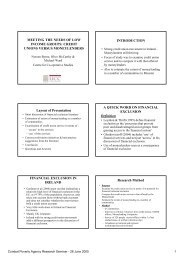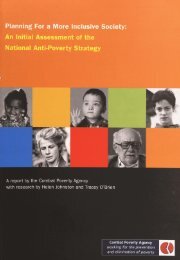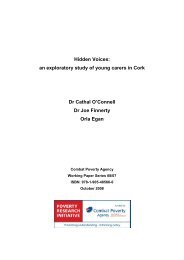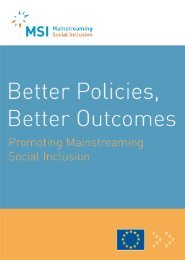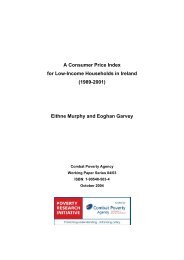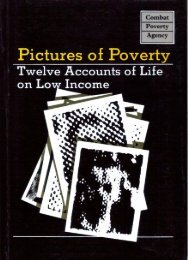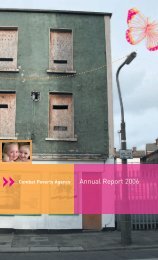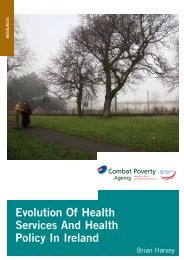The Distribution of Income in Ireland (2000) - Combat Poverty Agency
The Distribution of Income in Ireland (2000) - Combat Poverty Agency
The Distribution of Income in Ireland (2000) - Combat Poverty Agency
- No tags were found...
You also want an ePaper? Increase the reach of your titles
YUMPU automatically turns print PDFs into web optimized ePapers that Google loves.
22 <strong>The</strong> <strong>Distribution</strong> <strong>of</strong> <strong>Income</strong> <strong>in</strong> <strong>Ireland</strong>We beg<strong>in</strong> <strong>in</strong> Table 3.5 with three groups <strong>of</strong> households dist<strong>in</strong>guishedby whether the head is aged under 35, 35-64, or 65 orover. <strong>The</strong> table first shows the MLD for each <strong>of</strong> these sub-groups.Table 3.5: Decomposition <strong>of</strong> Inequality <strong>in</strong> Disposable Equivalised<strong>Income</strong> by Age <strong>of</strong> Head, 1994 and 1997 UI SurveyA:1994GroupUnder 3535 - under 6565 or overAllOf which:Inequalitywith<strong>in</strong> Group(MLD*1000)162168102160With<strong>in</strong> group <strong>in</strong>equality (% <strong>of</strong> total)Between group <strong>in</strong>equality (% <strong>of</strong> total)B: 1997Under 3535 - under 6565 or overAllOf which :175169121167With<strong>in</strong> group <strong>in</strong>equality (% <strong>of</strong> total)Between group <strong>in</strong>equality (% <strong>of</strong> total)Group Mean<strong>Income</strong>(£ per week)132.13124.90107.20123.64158 (98.8)2(1.2)177.65160.26132.17159.35163 (97.8)4 (2.2)Group Share <strong>in</strong>Population186814100196615100We see that <strong>in</strong> both years the level <strong>of</strong> with<strong>in</strong>-group <strong>in</strong>equality ismuch lower among those headed by someone aged 65 or overthan among the two younger groups. Households headed by anolder person also have lower mean <strong>in</strong>come than the other twogroups, even after adjustment for their smaller size. Inequalitybetween the groups accounts for less than 2 per cent <strong>of</strong> overall<strong>in</strong>equality, the rest be<strong>in</strong>g attributable to <strong>in</strong>equality with<strong>in</strong> theage groups. Inequality with<strong>in</strong> each <strong>of</strong> the age-groups and betweenthem all rose between 1994 and 1997.Table 3.6 focuses on households headed by a man or a coupleversus those with a female head. 2 Only 15 per cent <strong>of</strong>and Watson (1998) discuss alternatives to this crude categorisation.<strong>The</strong> <strong>Distribution</strong> <strong>of</strong> <strong>Income</strong> <strong>in</strong> the 1990s 23households are <strong>in</strong> the latter group, and the table shows that thelevel <strong>of</strong> <strong>in</strong>equality is less than among them than the rest <strong>of</strong> thesample, but that female-headed households have lower mean<strong>in</strong>comes than the rest <strong>of</strong> the population. Inequality with<strong>in</strong> thesetwo groups rather than between them accounts for almost allthe overall total, and this was unchanged between 1994 and1997.Table 3.6: Decomposition <strong>of</strong> Inequality <strong>in</strong> DisposableEquivalised <strong>Income</strong> by Sex <strong>of</strong> Head, 1994 and 1997 MI SurveyGroupInequalitywith<strong>in</strong> Group(MLD*1000)A: 1994Male or Couple161Female134All160Of which:With<strong>in</strong> group <strong>in</strong>equality (% <strong>of</strong> total)Between group <strong>in</strong>equality (% <strong>of</strong> total)B: 1997Male or CoupleFemaleAll164158167Of which:With<strong>in</strong> group <strong>in</strong>equality (% <strong>of</strong> total)Between group <strong>in</strong>equality (% <strong>of</strong> total)Group Mean<strong>Income</strong>(£ per week)127.39103.14123.64157 (98.3)3 (1.7)164.61126.83159.35163 (97.7)4 (2.3)Group Share <strong>in</strong>Population(%)85151008614100Table 3.7 categorises households by the labour force status <strong>of</strong>the head. <strong>The</strong>re is now a great deal <strong>of</strong> variation <strong>in</strong> <strong>in</strong>equalitywith<strong>in</strong> these groups. <strong>The</strong>re is a much higher degree <strong>of</strong> <strong>in</strong>equalityamong households headed by a self-employed person (<strong>in</strong>clud<strong>in</strong>gfarmers) than among those headed by an employee,and relatively little <strong>in</strong>equality among households headed bysomeone who is unemployed or ill, or engaged full-time <strong>in</strong>work<strong>in</strong>g <strong>in</strong> the home. <strong>The</strong>re are also now substantial differencesacross the groups <strong>in</strong> mean equivalised <strong>in</strong>come: householdsheaded by an employee or a self-employed person havemuch higher mean <strong>in</strong>comes than those with an unemployed or




